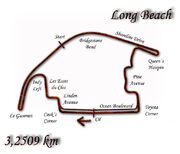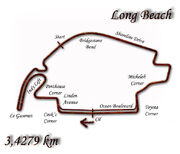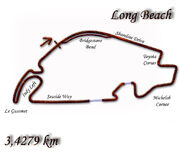(→1982) Tag: Visual edit |
|||
| (3 intermediate revisions by 2 users not shown) | |||
| Line 8: | Line 8: | ||
|firstgp= [[1976 United States Grand Prix West]] |
|firstgp= [[1976 United States Grand Prix West]] |
||
|lastgp= [[1983 United States Grand Prix West]] |
|lastgp= [[1983 United States Grand Prix West]] |
||
| ⚫ | }}The '''Long Beach Street Circuit''' is a temporary street circuit in Long Beach, California. The first race held was a Formula 5000 event in 1975, as a shakedown for a Formula One event, starting the following spring. There were a total of eight F1 races held before rising costs caused the management to switch to Indianapolis-style cars in 1984. The Indycars have been a fixture ever since. In 2015, the circuit also joined the Formula E series. |
||
| − | }} |
||
| ⚫ | |||
| ⚫ | |||
| − | [[File:Long Beach 1983.jpg|thumb|right|Circuit in 1983]] |
||
| ⚫ | The '''Long Beach Street Circuit''' is a temporary street circuit in Long Beach, California. The first race held was a Formula 5000 event in 1975, as a shakedown for a Formula One event, starting the following spring. There were a total of eight F1 races held before rising costs caused the management to switch to Indianapolis-style cars in 1984. The Indycars have been a fixture ever since. In 2015, the circuit also joined the Formula E series. |
||
==Circuit History== |
==Circuit History== |
||
| − | In 1973, when the City of Long Beach was planning a billion-dollar redevelopment for the downtown core, British expatriate and travel agent Chris Pook had an idea. He felt that Long Beach would never come out of the shadow of nearby Los Angeles without a unique and world-famous event, and what could be a better event than a Formula One race that emulated the [[Monaco Grand Prix]]. He eventually met former driver and constructor [[Dan Gurney]], who lived in the area and loved the idea. The two of them nursed the project through many financial and bureaucratic hurdles. They were finally granted a date on the 1976 Formula One calendar, contingent on a successful dry run |
+ | {{Quote box|"The Monaco of the New World."|[[Murray Walker]], [[1981 United States Grand Prix West]], [[British Broadcasting Corporation|BBC]] Commentary|salign=right}}In 1973, when the City of Long Beach was planning a billion-dollar redevelopment for the downtown core, British expatriate and travel agent Chris Pook had an idea. He felt that Long Beach would never come out of the shadow of nearby Los Angeles without a unique and world-famous event, and what could be a better event than a Formula One race that emulated the [[Monaco Grand Prix]]. He eventually met former driver and constructor [[Dan Gurney]], who lived in the area and loved the idea. The two of them nursed the project through many financial and bureaucratic hurdles. They were finally granted a date on the 1976 Formula One calendar, contingent on a successful dry run |
| + | |||
| + | <br><br>The 1975 Long Beach Grand Prix was a pure Formula 5000 race held on September 28. The organizers offered double the usual prize fund for a typical race of the North American Formula 5000 series, and in response a huge entry of 44 cars was received. 39 cars actually showed up, and to their dismay the officials discovered that the pit road was not long enough to accommodate all of them. So the field was broken in two, with a pair of 12 lap heats held, and the top 14 finishers in each moving on to the final. Included in the field were F1 names [[Chris Amon]], [[Mario Andretti]], [[Tony Brise]], [[George Follmer]], [[David Hobbs]], [[Brett Lunger]], [[Jackie Oliver]], [[Tom Pryce]], [[Brian Redman]], [[Jody Scheckter]], [[Vern Schuppan]], [[Al Unser|Al]] and [[Bobby Unser]] and [[Eppie Wietzes]]. |
||
==Circuit Layouts == |
==Circuit Layouts == |
||
===Previous Layouts=== |
===Previous Layouts=== |
||
====1976-1981==== |
====1976-1981==== |
||
| ⚫ | |||
| − | The circuit has always been a clockwise loop around the Long Beach sports arena and convention hall, the latter acting as the paddock. The original circuit used the section of Ocean Boulevard, between Pine and Linden, for the grid and start/finish line. Ocean is a divided 6-lane street, so the track used the westbound (north) side, and the pits were on the eastbound (south) side. A 90° right onto Linden took the cars on a sharply downhill block to the 90° left onto Seaside Way and the flat area of the circuit. A gentler right-hand bend took the cars into the parking lot of the arena and through a longer, sweeping left onto Shoreline Drive. Shoreline is another divided 6-lane road, with the course following it northeast, almost back to Ocean.<br /><br> |
+ | {{Quote box|"A semi-classic."|[[Murray Walker]], [[1981 United States Grand Prix West]], [[British Broadcasting Corporation|BBC]] Commentary|salign=right}}The circuit has always been a clockwise loop around the Long Beach sports arena and convention hall, the latter acting as the paddock. The original circuit used the section of Ocean Boulevard, between Pine and Linden, for the grid and start/finish line. Ocean is a divided 6-lane street, so the track used the westbound (north) side, and the pits were on the eastbound (south) side. A 90° right onto Linden took the cars on a sharply downhill block to the 90° left onto Seaside Way and the flat area of the circuit. A gentler right-hand bend took the cars into the parking lot of the arena and through a longer, sweeping left onto Shoreline Drive. Shoreline is another divided 6-lane road, with the course following it northeast, almost back to Ocean.<br /><br> |
After a 180 degree right hairpin, the cars headed down the back straight (still on Shoreline), which was a bit of a misnomer, as a series of gentle bends turns the track more than 100° to the right along it's 3/4 mile length. At the intersection of Shoreline and Pacific, another 180° right (soon labeled "The Queen's Hairpin", for the nearby ''Queen Mary'' liner, now permanently docked there) sent the cars back to Pine Avenue, where the cars turned north. A quick right/left jog had the cars in another parking lot until reaching Seaside again, where a left/right jog puts the cars on the sharp uphill back to Ocean. A sweeping right past the pit entrance and the cars were on the front straight again, which itself was actually slightly downhill after the timing line.<br><br> |
After a 180 degree right hairpin, the cars headed down the back straight (still on Shoreline), which was a bit of a misnomer, as a series of gentle bends turns the track more than 100° to the right along it's 3/4 mile length. At the intersection of Shoreline and Pacific, another 180° right (soon labeled "The Queen's Hairpin", for the nearby ''Queen Mary'' liner, now permanently docked there) sent the cars back to Pine Avenue, where the cars turned north. A quick right/left jog had the cars in another parking lot until reaching Seaside again, where a left/right jog puts the cars on the sharp uphill back to Ocean. A sweeping right past the pit entrance and the cars were on the front straight again, which itself was actually slightly downhill after the timing line.<br><br> |
||
In 1978, the start was moved to a point roughly {{frac|1|2}} of the way along Shoreline Drive, just before the wide Bridgestone Bend. So for the next four races, the actual race distance was 79{{frac|1|2}} laps. |
In 1978, the start was moved to a point roughly {{frac|1|2}} of the way along Shoreline Drive, just before the wide Bridgestone Bend. So for the next four races, the actual race distance was 79{{frac|1|2}} laps. |
||
====1982==== |
====1982==== |
||
| ⚫ | |||
| − | [[1982 United States Grand Prix West|1982]] saw the first major changes in the track configuration. The race was created to help revitalize a rather moribund part of town, but now it was a victim of its own success. Downtown Long Beach was undergoing a building boom, and portions of the circuit were no longer usable. First, a major expansion of the convention center had eaten up the parking lot used for the jog off of Pine Avenue, and the street itself was being rebuilt. So instead of a 180° right, the cars went into a tight right/left/right section with short straights in between. That led to a new section of Seaside Way, which gently curved back to Pine, where the cars now turned sharp left to go uphill and reach the pits. |
+ | [[1982 United States Grand Prix West|1982]] saw the first major changes in the track configuration. The race was created to help revitalize a rather moribund part of town, but now it was a victim of its own success. Downtown Long Beach was undergoing a building boom, and portions of the circuit were no longer usable. First, a major expansion of the convention center had eaten up the parking lot used for the jog off of Pine Avenue, and the street itself was being rebuilt. So instead of a 180° right, the cars went into a tight right/left/right section with short straights in between. That led to a new section of Seaside Way, which gently curved back to Pine, where the cars now turned sharp left to go uphill and reach the pits. |
| ⚫ | After shooting past the pits, and downhill on Linden back to Seaside, the straight on Seaside was lengthened slightly. This changed the turn south a more challenging 135° right, instead of the old 90° kink. This made the turn onto Shoreline functionally a hairpin of more than 180°, but the radius was increasing throughout. The hairpin at Ocean Blvd. (now called ''Le Gasomet |
||
| + | |||
| + | <br><br> |
||
| ⚫ | After shooting past the pits, and downhill on Linden back to Seaside, the straight on Seaside was lengthened slightly. This changed the turn south a more challenging 135° right, instead of the old 90° kink. This made the turn onto Shoreline functionally a hairpin of more than 180°, but the radius was increasing throughout. The hairpin at Ocean Blvd. (now called ''Le Gasomet'' for unknown reasons) was unchanged, but a short ways down the straight, just before the start line, a chicane around a traffic island was inserted. The new circuit length was increased slightly to 3.428 km, with average speeds reduced by 10 km/h.[[File:Long Beach 1983.jpg|thumb|right|Circuit in 1983]] |
||
====1983==== |
====1983==== |
||
| Line 34: | Line 36: | ||
==Event history== |
==Event history== |
||
The following is a list of Formula One World Championship events held at the Long Beach circuit: |
The following is a list of Formula One World Championship events held at the Long Beach circuit: |
||
| − | {|class="wikitable" |
+ | {| class="wikitable" |
! Year |
! Year |
||
! Winning Driver |
! Winning Driver |
||
| Line 82: | Line 84: | ||
==Notes== |
==Notes== |
||
| − | < |
+ | <references /> |
{{Circuits}} |
{{Circuits}} |
||
Revision as of 05:32, 21 February 2019
The Long Beach Street Circuit is a temporary street circuit in Long Beach, California. The first race held was a Formula 5000 event in 1975, as a shakedown for a Formula One event, starting the following spring. There were a total of eight F1 races held before rising costs caused the management to switch to Indianapolis-style cars in 1984. The Indycars have been a fixture ever since. In 2015, the circuit also joined the Formula E series.
Circuit History
"The Monaco of the New World."
In 1973, when the City of Long Beach was planning a billion-dollar redevelopment for the downtown core, British expatriate and travel agent Chris Pook had an idea. He felt that Long Beach would never come out of the shadow of nearby Los Angeles without a unique and world-famous event, and what could be a better event than a Formula One race that emulated the Monaco Grand Prix. He eventually met former driver and constructor Dan Gurney, who lived in the area and loved the idea. The two of them nursed the project through many financial and bureaucratic hurdles. They were finally granted a date on the 1976 Formula One calendar, contingent on a successful dry run
The 1975 Long Beach Grand Prix was a pure Formula 5000 race held on September 28. The organizers offered double the usual prize fund for a typical race of the North American Formula 5000 series, and in response a huge entry of 44 cars was received. 39 cars actually showed up, and to their dismay the officials discovered that the pit road was not long enough to accommodate all of them. So the field was broken in two, with a pair of 12 lap heats held, and the top 14 finishers in each moving on to the final. Included in the field were F1 names Chris Amon, Mario Andretti, Tony Brise, George Follmer, David Hobbs, Brett Lunger, Jackie Oliver, Tom Pryce, Brian Redman, Jody Scheckter, Vern Schuppan, Al and Bobby Unser and Eppie Wietzes.
Circuit Layouts
Previous Layouts
1976-1981

Circuit from 1978-81
"A semi-classic."
The circuit has always been a clockwise loop around the Long Beach sports arena and convention hall, the latter acting as the paddock. The original circuit used the section of Ocean Boulevard, between Pine and Linden, for the grid and start/finish line. Ocean is a divided 6-lane street, so the track used the westbound (north) side, and the pits were on the eastbound (south) side. A 90° right onto Linden took the cars on a sharply downhill block to the 90° left onto Seaside Way and the flat area of the circuit. A gentler right-hand bend took the cars into the parking lot of the arena and through a longer, sweeping left onto Shoreline Drive. Shoreline is another divided 6-lane road, with the course following it northeast, almost back to Ocean.
After a 180 degree right hairpin, the cars headed down the back straight (still on Shoreline), which was a bit of a misnomer, as a series of gentle bends turns the track more than 100° to the right along it's 3/4 mile length. At the intersection of Shoreline and Pacific, another 180° right (soon labeled "The Queen's Hairpin", for the nearby Queen Mary liner, now permanently docked there) sent the cars back to Pine Avenue, where the cars turned north. A quick right/left jog had the cars in another parking lot until reaching Seaside again, where a left/right jog puts the cars on the sharp uphill back to Ocean. A sweeping right past the pit entrance and the cars were on the front straight again, which itself was actually slightly downhill after the timing line.
In 1978, the start was moved to a point roughly 1⁄2 of the way along Shoreline Drive, just before the wide Bridgestone Bend. So for the next four races, the actual race distance was 791⁄2 laps.
1982

Circuit in 1982
1982 saw the first major changes in the track configuration. The race was created to help revitalize a rather moribund part of town, but now it was a victim of its own success. Downtown Long Beach was undergoing a building boom, and portions of the circuit were no longer usable. First, a major expansion of the convention center had eaten up the parking lot used for the jog off of Pine Avenue, and the street itself was being rebuilt. So instead of a 180° right, the cars went into a tight right/left/right section with short straights in between. That led to a new section of Seaside Way, which gently curved back to Pine, where the cars now turned sharp left to go uphill and reach the pits.
After shooting past the pits, and downhill on Linden back to Seaside, the straight on Seaside was lengthened slightly. This changed the turn south a more challenging 135° right, instead of the old 90° kink. This made the turn onto Shoreline functionally a hairpin of more than 180°, but the radius was increasing throughout. The hairpin at Ocean Blvd. (now called Le Gasomet for unknown reasons) was unchanged, but a short ways down the straight, just before the start line, a chicane around a traffic island was inserted. The new circuit length was increased slightly to 3.428 km, with average speeds reduced by 10 km/h.

Circuit in 1983
1983
Current
Event history
The following is a list of Formula One World Championship events held at the Long Beach circuit:
| Year | Winning Driver | Winning Constructor | Report |
|---|---|---|---|
| 1976 | Report | ||
| 1977 | Report | ||
| 1978 | Report | ||
| 1979 | Report | ||
| 1980 | Report | ||
| 1981 | Report | ||
| 1982 | Report | ||
| 1983 | Report |
Notes
| v·d·e | Nominate this page for Featured Article |
